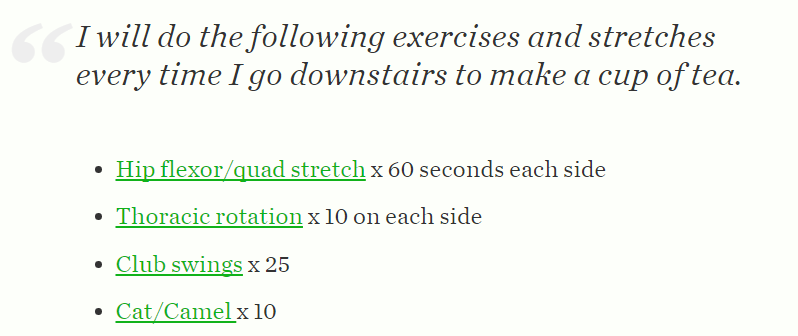| This is a guest post from one of my favorite authors and wellness enthusiasts, Nate Green. I encourage you all to check out more of Nate's work at The Nate Green Experience |
Today I’m starting a habit I hope to keep for the rest of my life.
It will help my body feel better throughout the day. It will serve as a small break from doing my work. And it will make every physical activity I do (inside and outside of the gym) more effective.
Today I’m starting to stretch at home.
And since I’m starting this new habit today, I thought it’d be a perfect time to give an inside look on how I start—and keep—new habits that are good for me.1
When habits fail
In my experience, we fail to adopt or keep new habits for 3 reasons:
Today I’m starting to stretch at home.
And since I’m starting this new habit today, I thought it’d be a perfect time to give an inside look on how I start—and keep—new habits that are good for me.1
When habits fail
In my experience, we fail to adopt or keep new habits for 3 reasons:
- We don’t feel a deep need to change and adopt the new habit; instead, it’s just a “good idea” we’d like to try
- The habit is unclear. Or it’s too big.
- We don’t have a plan or process for practicing the habit
How to break down a new habit and start practicing
Let’s stick with stretching, the new habit I want to start and keep.2
1. Define why it matters
I sit or stand at a desk in front of my computer3 for 3-6 hours per day, depending on what I’m working on.
Even though I have an ergonomic chair, a large computer monitor, and a desk that adjusts from standing-height to sitting-height, I still feel tight throughout the day.
My shoulders slump and my head protrudes forward, stressing my neck and occasionally causing headaches. When I’m sitting, my hips are flexed at 90 degrees, causing my hip muscles to tighten. And my elbows tend to flare out when I’m typing, which over time has irritated my right shoulder.
Basically, I feel awkward and tight most of the day.
I want to start stretching because I believe it’ll help alleviate some of the pain and awkwardness I feel and “reset” my body, if only slightly.
So there’s my reason for why it matters to me.
2. Make the habit super-specific
Earlier I said my new habit is to start stretching. But that’s not quite right.
Stretching is too big. It doesn’t really mean anything. It’s notspecific.
When will I stretch? For how long? What kind of stretches? What about strengthening or mobility exercises––are those covered under “stretching”? How often will I “stretch?” And so on.
So instead of saying “I’m going to stretch”, I’m making my habit super-specific:
Let’s stick with stretching, the new habit I want to start and keep.2
1. Define why it matters
I sit or stand at a desk in front of my computer3 for 3-6 hours per day, depending on what I’m working on.
Even though I have an ergonomic chair, a large computer monitor, and a desk that adjusts from standing-height to sitting-height, I still feel tight throughout the day.
My shoulders slump and my head protrudes forward, stressing my neck and occasionally causing headaches. When I’m sitting, my hips are flexed at 90 degrees, causing my hip muscles to tighten. And my elbows tend to flare out when I’m typing, which over time has irritated my right shoulder.
Basically, I feel awkward and tight most of the day.
I want to start stretching because I believe it’ll help alleviate some of the pain and awkwardness I feel and “reset” my body, if only slightly.
So there’s my reason for why it matters to me.
2. Make the habit super-specific
Earlier I said my new habit is to start stretching. But that’s not quite right.
Stretching is too big. It doesn’t really mean anything. It’s notspecific.
When will I stretch? For how long? What kind of stretches? What about strengthening or mobility exercises––are those covered under “stretching”? How often will I “stretch?” And so on.
So instead of saying “I’m going to stretch”, I’m making my habit super-specific:
There’s no ambiguity here4. I know exactly what I’m going to do and when I’m going to do it. Which brings us to…
3. Set a trigger to remind you to do the habit
You’ll notice I said I’m going to follow my little routine every time I go downstairs to make a cup of tea.
Making tea is the trigger to remind me to do my new habit. A trigger is something you already habitually do, a thing you can “piggyback” your new habit on.
Since I work from home, I go downstairs to make tea at least two or three times per day. And normally I just stare into space while the water boils and the tea steeps.
By putting my new habit (stretching) on top of something I’m already doing (making tea), I’m way more likely to remember to do it. Plus, I’ll end up following my stretching routine at least two or three times per day, which my body will thank me for.
Setting a trigger is the only reason I’ve also started regularly meditating (20 minutes per day after I have my morning coffee) and reading fiction (30-60 minutes before bed).
You’ll notice I said I’m going to follow my little routine every time I go downstairs to make a cup of tea.
Making tea is the trigger to remind me to do my new habit. A trigger is something you already habitually do, a thing you can “piggyback” your new habit on.
Since I work from home, I go downstairs to make tea at least two or three times per day. And normally I just stare into space while the water boils and the tea steeps.
By putting my new habit (stretching) on top of something I’m already doing (making tea), I’m way more likely to remember to do it. Plus, I’ll end up following my stretching routine at least two or three times per day, which my body will thank me for.
Setting a trigger is the only reason I’ve also started regularly meditating (20 minutes per day after I have my morning coffee) and reading fiction (30-60 minutes before bed).
What to try
Of course, this is just my process. You’ll have to experiment to find out what works best for you. But the next time you want to start a new habit, it may help to keep this 3-step process in mind:
Good luck.
Of course, this is just my process. You’ll have to experiment to find out what works best for you. But the next time you want to start a new habit, it may help to keep this 3-step process in mind:
- Define why it matters
- Make the habit super-specific
- Set a trigger to remind you to do the habit
Good luck.
Be sure to visit The Nate Green Experience for more exceptional articles.




